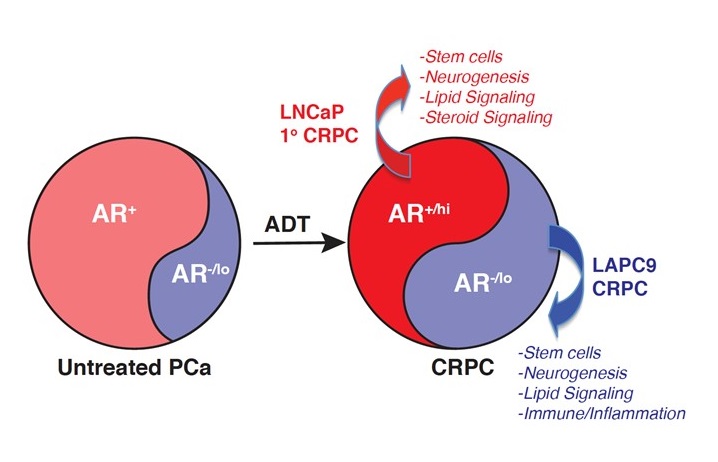Prostate Cancer
Linking Androgen Receptor Heterogeneity in Prostate Cancer to AR-Targeting Therapies



Posted January 30, 2019
Dean Tang, Ph.D., Roswell Park Comprehensive Cancer Center

Patients with advanced prostate cancer (PCa) are normally treated with androgen-deprivation therapy (ADT). ADT works by blocking androgen receptor (AR) signaling, which is a driver of PCa development and progression. Initially, ADT can be very effective at controlling PCa growth, although if some cancer cells do not respond to the treatment, the tumor can become resistant to ADT, leading to the development of castration-resistant prostate cancer (CRPC), which has limited therapeutic options. Recent evidence from the laboratory of Dr. Dean Tang at Roswell Park Comprehensive Cancer Center provides insight into ADT resistance by showing that some PCa cells within a tumor express little or no AR (called AR-/lo). These cells do not respond to ADT treatment de novo and can become very aggressive, highlighting a need to develop new targeted therapies for CRPC.
With support from a FY15 PCRP Impact Award, Dr. Tang sought to identify novel mechanisms for targeting unresponsive AR-/lo cells as well as those CRPC cells with functional AR signaling (AR+/hi). Dr. Tang’s ultimate goal for this project is to provide proof-of-concept therapeutic regimens for both cell types of CRPC. Through this work, Dr. Tang was able to identify unique gene signaling patterns for AR+/hi and AR-/lo PCa cells. His team found that both AR+/hi and AR-/lo subtypes of CRPC clones share commonly enriched gene signatures for “stem cells”, “neurogenesis”, and “lipid signaling” whereas the AR+/hi subtype of CRPC uniquely expresses “steroid signaling’ genes, and the AR-/lo subtype of CRPC is enriched in “immune/inflammation” gene signatures. Since stem cell genes were common between the two cell types, Dr. Tang focused his studies on a well-known stem cell pro-survival gene called BCL-2. Through xenograft-based therapeutic experiments, Dr. Tang showed that combinatorial treatment with AR inhibitor enzalutamide and the recently FDA-approved BCL-2 drug ABT-199 (venetoclax) inhibits both AR+/hi and AR-/lo PCa cells by more than 75%.
This study has important implications in understanding the cellular basis of PCa responses to ADT and in facilitating development of novel therapeutics for CRPC. Based on these findings, Dr. Tang and his collaborators have initiated a first-in-field phase Ib/II clinical trial to co-target both AR+/hi and AR-/lo PCa cell populations and are working to translate these result to the clinic as fast as possible. This trial, looking at the combination of enzalutamide and ABT-199, will be recruiting patients in early 2019. Ultimately, Dr. Tang hopes this work will lead to the development of new therapy for CRPC patients and possibly even prevent the development of resistance through better treatment of all cells in the primary tumor.

Figure: AR+ and AR-/lo PCa cell populations that pre-exist in untreated prostate tumors, co-evolve under the persistent selection pressure from clinical treatments, i.e., ADT (androgen deprivation therapy; chemical castration and/or antiandrogens such as enzalutamide). This co-evolution leads to the generation of AR+/hi and the expanded AR-/lo PCa cells/clones in CRPC (Figure 8k in the paper). Interestingly, the LNCaP primary (10) CRPC represents the AR+/hi subtype of CRPC while the LAPC9 CRPC represents the AR-/lo CRPC. The two types of CRPC clones share commonly enriched gene signatures for “Stem Cells”, “Neurogenesis”, and “Lipid Signaling” whereas the AR+/hi LNCaP subtype of CRPC uniquely expresses “Steroid Signaling’ genes and the AR-/lo LAPC9 subtype of CRPC is enriched in “Immune/Inflammation” gene signatures. To achieve long-lasting and curative clinical effects, both populations of PCa cells need to be therapeutically targeted.
Reference:
1. Linking prostate cancer cell AR heterogeneity to distinct castration and enzalutamide responses. Li Q1, Deng Q, Chao HP, Liu X, Lu Y, Lin K, Liu B, Tang GW, Zhang D, Tracz A, Jeter C, Rycaj K, Calhoun-Davis T, Huang J, Rubin MA, Beltran H, Shen J, Chatta G, Puzanov I, Mohler JL, Wang J, Zhao R, Kirk J, Chen X, Tang DG. s.l. : NATURE COMMUNICATIONS, 2018, NATURE COMMUNICATIONS, p. 9:3600.Link:
Last updated Thursday, December 5, 2024














